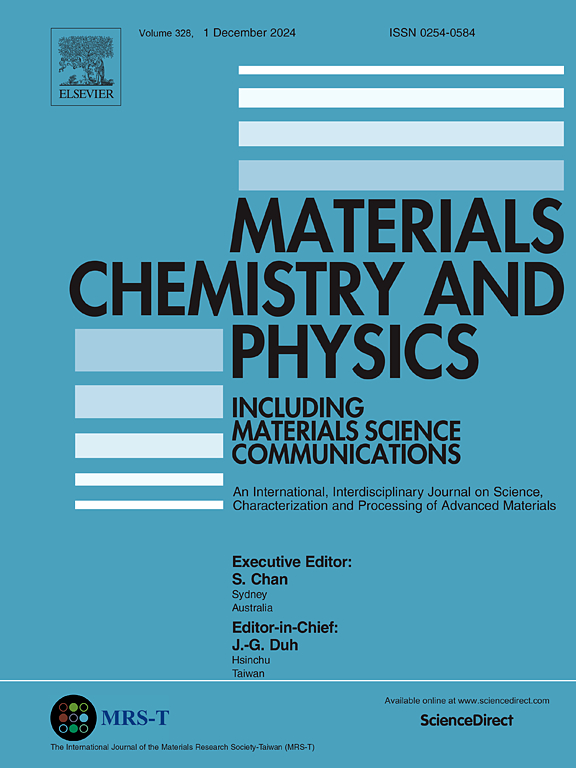核壳硅酸盐颗粒的药物装载与释放:硫胺素类药物的案例研究
IF 4.3
3区 材料科学
Q2 MATERIALS SCIENCE, MULTIDISCIPLINARY
引用次数: 0
摘要
研究了球形介孔二氧化硅和核壳硅酸盐颗粒作为新型给药平台负载盐酸硫胺素水溶性药物。以十二烷基胺为模板剂,采用Stober法合成了该颗粒,并通过适当的热处理将其去除,留下介孔。在硅芯上形成氧化铝或铝铁氧化物混合物的壳层,以扩展这些颗粒的应用领域。采用扫描电子显微镜(SEM)、比表面积和孔隙率、粒径分布和Zeta电位、x射线衍射(XRD)、差热分析(DTA/TGA)、x射线光电子能谱(XPS)、傅立叶变换红外光谱(FTIR)以及紫外-可见分光光度法评估溶出度等实验技术,对二氧化硅和核壳颗粒进行了载药和释放的表征。采用溶剂蒸发法将盐酸硫胺素负载到这些颗粒上作为模型药物。XRD结果表明,所载药物的结晶状态为盐酸硫胺素一水。根据DTA/TGA数据,加载后的样品中含有几乎等量的介孔颗粒和硫胺素。XPS分析表明硫胺素存在于球体表面,但进入硫胺素的元素浓度较低,而颗粒组成中出现的元素浓度较高,表明硫胺素主要被包裹在颗粒的孔隙中。另一方面,FTIR光谱还表明硫胺素通过氢键附着在颗粒的内表面和/或外表面。研究发现,载硫胺素的颗粒有药物释放延迟。本文章由计算机程序翻译,如有差异,请以英文原文为准。

Drug loading and release from core-shell silicate particles: a case study for thiamine drug
Spherical mesoporous silica and core-shell silicate particles loaded with thiamine hydrochloride water-soluble drug were investigated as new drug delivery platforms. The particles were synthesized by Stober method using dodecylamine as organic template, which was removed through a suitable heat treatment and left behind mesopores. A shell of aluminum oxide or a mixture of aluminum and iron oxides was developed on silica cores to extend the application fields of these particles. Both silica and core–shell particles were characterized as matrices for drug loading and release using various experimental techniques as scanning electron microscopy (SEM), specific surface area and porosity, particle size distributions and Zeta potential, X-ray diffraction (XRD), differential thermal analysis (DTA/TGA), X-ray photoelectron spectroscopy (XPS), Fourier transform infrared (FTIR) spectroscopy, as well as dissolution tests evaluated by UV-VIS spectrophotometry. Thiamine hydrochloride loaded onto these particles by solvent evaporation method was used as a model drug. The XRD results showed that the crystalline state of the loaded drug is thiamine hydrochloride monohydrate. According to DTA/TGA data, after the loading process the samples contain almost equal amounts of mesoporous particles and thiamine. The XPS analysis indicated the presence of thiamine on the surface of the spheres, but the low concentration of the elements entering the thiamine and the high concentration of the elements occurring from particles composition reveal that thiamine is mainly entrapped inside the pores of the particles. On the other hand, FTIR spectroscopy additionally indicated that thiamine is attached to the inner and/or outer surface of the particles via hydrogen bonds. A drug release delay was noticed for the investigated particles loaded with thiamine.
求助全文
通过发布文献求助,成功后即可免费获取论文全文。
去求助
来源期刊

Materials Chemistry and Physics
工程技术-材料科学:综合
CiteScore
8.70
自引率
4.30%
发文量
1515
审稿时长
69 days
期刊介绍:
Materials Chemistry and Physics is devoted to short communications, full-length research papers and feature articles on interrelationships among structure, properties, processing and performance of materials. The Editors welcome manuscripts on thin films, surface and interface science, materials degradation and reliability, metallurgy, semiconductors and optoelectronic materials, fine ceramics, magnetics, superconductors, specialty polymers, nano-materials and composite materials.
 求助内容:
求助内容: 应助结果提醒方式:
应助结果提醒方式:


